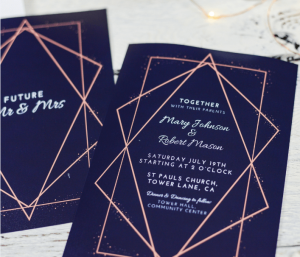Foiling services work their best magic when the most skilful people in the industry provide them. Having specialised in this field for years, we believe we are the right company to handle your needs. With every project, we strive to deliver a standard of work that is nothing short of first rate.
Use a vector
 People often use foils to create artwork. There are several important details to note about producing designs for foil. For one thing, it has to be created inside a vector. You can’t use bitmap/raster. The reason is that you output the artwork on film at a resolution of over 2k dots per inch. Normally, high resolution bitmap art stands at 300 dots per inch. This would lead to a die that has jagged edges. Such a set up will cause foiling complications. Your final product is going to end up looking awful.
People often use foils to create artwork. There are several important details to note about producing designs for foil. For one thing, it has to be created inside a vector. You can’t use bitmap/raster. The reason is that you output the artwork on film at a resolution of over 2k dots per inch. Normally, high resolution bitmap art stands at 300 dots per inch. This would lead to a die that has jagged edges. Such a set up will cause foiling complications. Your final product is going to end up looking awful.
With vector art however, there is no resolution. It is all mathematical curves and lines that you can reduce or expand without influencing the resolution. As a result, it will look better.
What this means in practicality is that you will have to produce your artwork in InDesign or Illustrator. Alternatively, you would need to use another program capable of producing vector files. These include EPS and PDF files. Contact us if you are after the finest foiling services in the industry.
100% values only
The next important thing we would like to talk about is that you are only free to use 100% values. You are unable to make a gradient within a foil and you also cannot do shading. What you can do is black and white only, no greys. The reason is that the film output only has white and black. Greys end up getting output as a dot pattern. This makes for an unusable die. As a result, die art must be produced within a CMYK colour space. Here, the black is completely black. There are no 0 values of B, G, and R.
Other things to think about
There are a few other points we should also mention. Your foils might have to register to artwork on your printed sheet. If so, you must have a registration mark within your foil artwork that is repeated on the printed sheet too. This has to be on the exterior of the final cut/crop line of the artwork.
Additionally, you can’t make lines any thinner than 1pt. This is particularly crucial if your plan is to utilise magnesium dies as a raised area that is thin. It will likely go away after a few hundred impressions.
Our foiling services are high quality and affordable
We are one of the most trustworthy names working in our field. This gives people the utmost confidence when they are dealing with us.
Something else we would like to stress is that we don’t charge premium prices for our work. We like making our foiling services affordable to everyone, from businesses to end users. So, if we can be of help to you, please get in touch with us.
